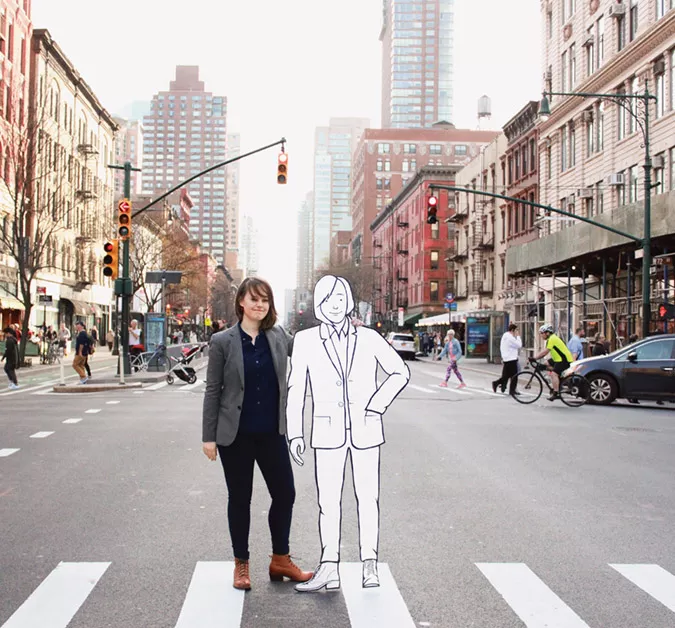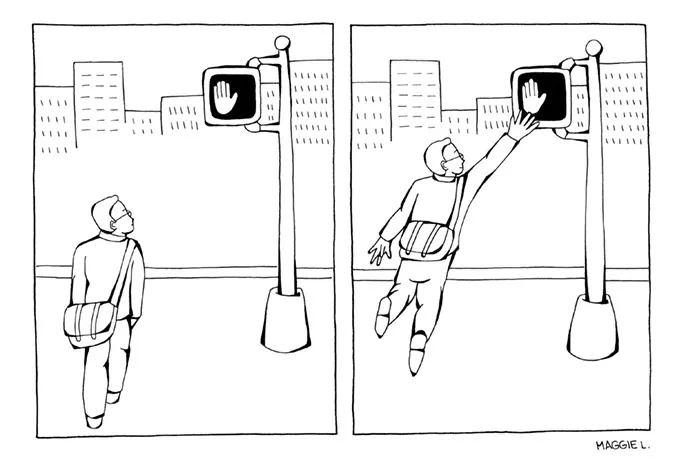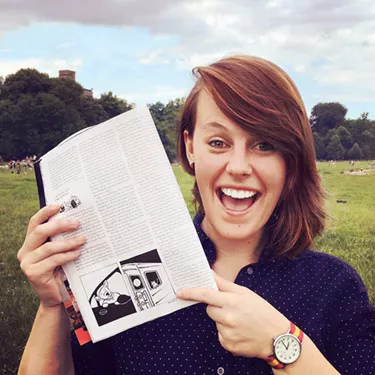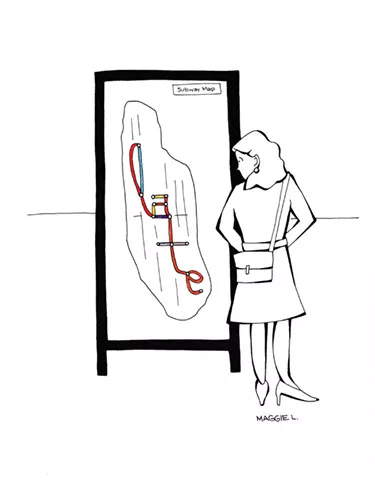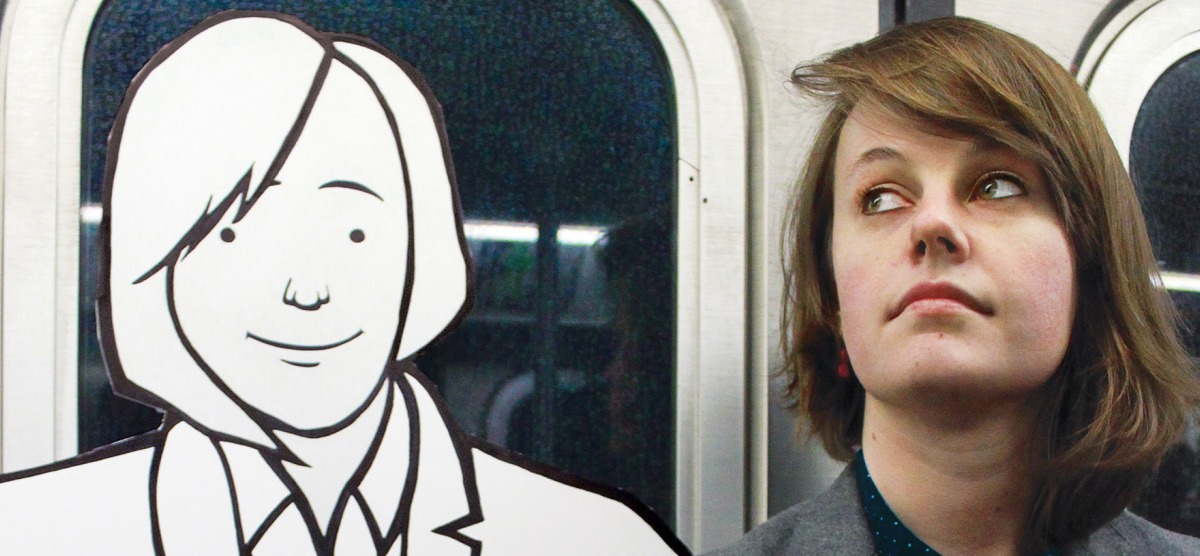
A Very Semi-Serious Woman
Cartoonist Maggie Larson ’10 tells whimsical stories with a touch of sweetness.
The 2015 documentary Very Semi-Serious shows aspiring cartoonists undertaking the grueling ritual required to land a cartoon in the New Yorker. Scores of them arrive once a week at the office of (now retired) cartoon editor Bob Mankoff with several pieces of work in hand. Of the approximately 1,000 cartoons submitted each week, approximately 15 make it into the magazine.
Those odds did not daunt Maggie Larson ’10. For Larson, who thumbed through her parents’ issues of the New Yorker throughout her childhood, being published in the storied publication was a lifelong dream. After seeing the film, she was more determined than ever to pursue the holy grail of cartooning. “I remember it feeling almost like a calling,” she says.
Larson pored over the single-panel format favored by the magazine, picked the brains of other New Yorker cartoonists, and began creating a portfolio of potential submissions. In June 2016, she made her first visit to Mankoff and waited as the legendary editor reviewed hard copies of her work.
Nothing sold, but Larson was encouraged enough by the feedback to keep going. While balancing a demanding full-time job in the non-profit arena, yoga classes, musical pursuits, and, somehow, a social life, she has carved out time to create and submit the requisite six to 10 new cartoons every week since that first attempt.
About a year and some 250 submissions later, Larson made her first sale. Today seven of her cartoons have appeared in the magazine, two more as part of the “Daily Shouts” feature on newyorker.com, and one is pending publication.
“When my first cartoon was published, I stopped at Whole Foods and picked up 10 copies of the issue,” she recalls. “The woman at the register remarked on my purchase, and I showed her my work. She just glanced at the spread and asked, ‘Did you write the article as well?’”
“That took me down a few notches,” Larson says with a laugh.
Larson’s experience at the grocery store “really speaks to her approach to her career and life,” says fellow New Yorker cartoonist Amy Kurzweil. “Maggie is grateful and excited and quick to feel humbled without losing pride or confidence in what she’s achieved.”
Those close to Larson say humility and confidence are two of the seemingly paradoxical characteristics she inhabits comfortably. Her former instructor Jody Cohen, a term professor in the Bryn Mawr/Haverford education program, notes, “Maggie’s perfectionism and intensity have enabled her to develop her gift to a stunning point, but she’s also able to laugh at herself.” And Zanny Alter ’09, Larson’s friend and classmate, says the “earnestness and seriousness” with which Larson approaches every endeavor coexists with her infectious sense of humor and irrepressible love of puns.
This constellation of traits shapes not only Larson’s personal and professional interactions but also her art, which injects whimsy into the everyday and treats subjects with both honesty and generosity.
“The stories Maggie’s cartoons tell are often sweet,” Kurzweil says. “There isn’t a butt of her jokes or someone who ends up looking like a fool, as you see in some cartoons.”
Larson doesn’t reserve her cartooning for the New Yorker. Her friends and family have long received hand-crafted birthday cards with cartoons that always hone in on what’s important or distinct to the recipient. And Larson acquired a reputation at Bryn Mawr for peppering the campus with posters that memorialized shared moments and inside jokes with faculty, staff, and fellow students.
“You always feel like Maggie is paying attention to your life in a special way,” Alter says. “She takes something about you that can be so small and makes it into something surprising and memorable. In this age of smartphones and tablets, it feels like everyone’s only half aware of what’s happening around them, but Maggie’s always operating on a higher level. She’s always thinking.”
In many ways, Larson’s path to cartooning success is rooted in the strong bonds she shares with her family. Her parents infused her Portland, Oregon, upbringing with art and music and actively nurtured her creativity. “I remember them encouraging me to make and color in my own drawings rather than buying me coloring books,” she says.
Of all the art forms Larson engaged in throughout grade school, cartooning became her favorite. “One of the things that’s really compelling about cartooning for me is the efficiency of line and just how clear it is,” Larson says. “I love how much you can communicate so much with so little. I also like how playful and inviting it can be; you’re really having fun with the world.”
Drawing continued to be an important hobby during Larson’s time at Bryn Mawr and she cartooned for the College News. However, she focused her time as a student exploring a new set of intellectual interests as a Growth and Structure of Cities major and education minor. The interdisciplinary nature of her studies and the opportunity to think on a macro level about education in an urban setting led to a job at YouthBuild Charter School for students who had previously dropped out of high school. Positions at educational non-profits, like the Posse Foundation, followed. This March, she joined Idealist as a community engagement manager.
Larson experiences working with youth have pushed her to think more deeply about how to connect with people over differences, whether in abilities, backgrounds, or perspectives. In addition, she says her Cities major helped facilitate the depth of inspiration she takes from the urban centers she has called home: Portland, Philadelphia, and New York. In fact, she moved to New York specifically to tap into an energy she hoped would help her take her art to a more professional level.
“You receive so much visually just walking down the street in cities,” Larson says. “And a city like New York has all these different nooks and crannies to it, and so many characters who are almost art forms in their own right.”
In order to generate the volume of ideas necessary to create six to 10 cartoons a week, Larson carries a sketch book with her everywhere. She takes notes—images as well as words—as quickly and immediately as possible.
Subway commutes, an offhand quip during an outing with friends, the architecture in Washington Square Park – anything can spark a caption or the concept for a drawing. One of Larson’s earliest New Yorker cartoons, a juxtaposition of tourist and local footprints in the snow, came together in 15 minutes as she stared out of the window one day in deep winter. Other submissions, however, come from weeks or months reworking ideas or even old cartoons.
The batches are due to the New Yorker every Tuesday. Although the magazine’s current cartoon editor, Emma Allen, prefers electronic submissions exclusively, Larson still goes to the New Yorker offices every couple weeks to get feedback on previously submitted work or pitch “Daily Shout” ideas in person.
Every Sunday, Larson, who prefers to work in paper even as many of her peers work digitally, sits down with to draw with her favored Rapidograph pens and Bristol smooth paper. She admits there are weeks when the ideas don’t flow, but the act of persevering has played a key part in her growth as an artist.
“Sometimes I sit down on a Sunday and think, ‘I don’t know why I put myself through this.’ But I’ve learned to not be too precious about my work and unlearn qualities, like being too much of a perfectionist. It’s not that you become an assembly line, but you just can’t risk getting too stuck in your own head. If you push yourself to start, even before you’re totally ready, then you’re making something. Then, you’ve accomplished something.”
Published on: 05/13/2018

